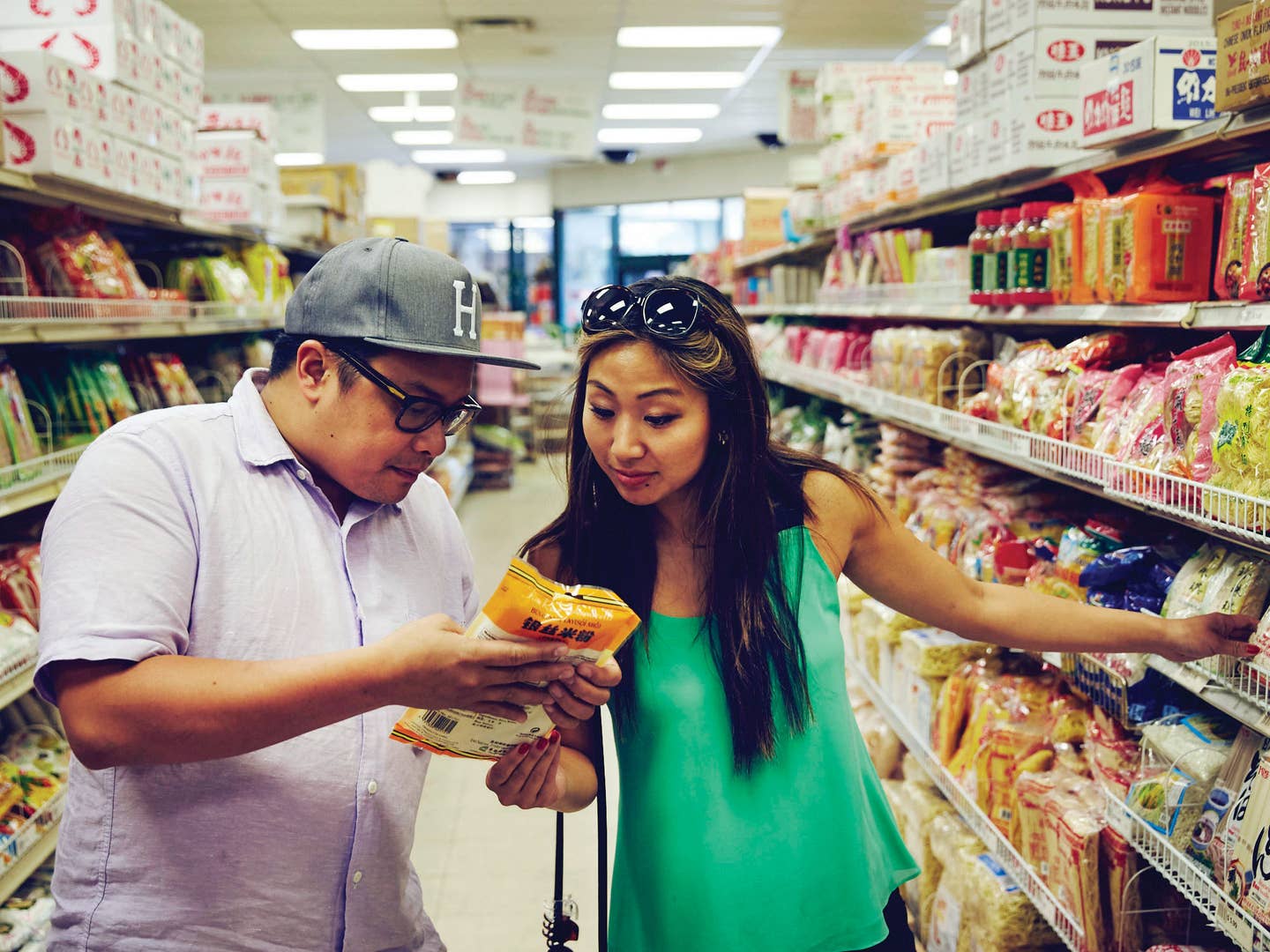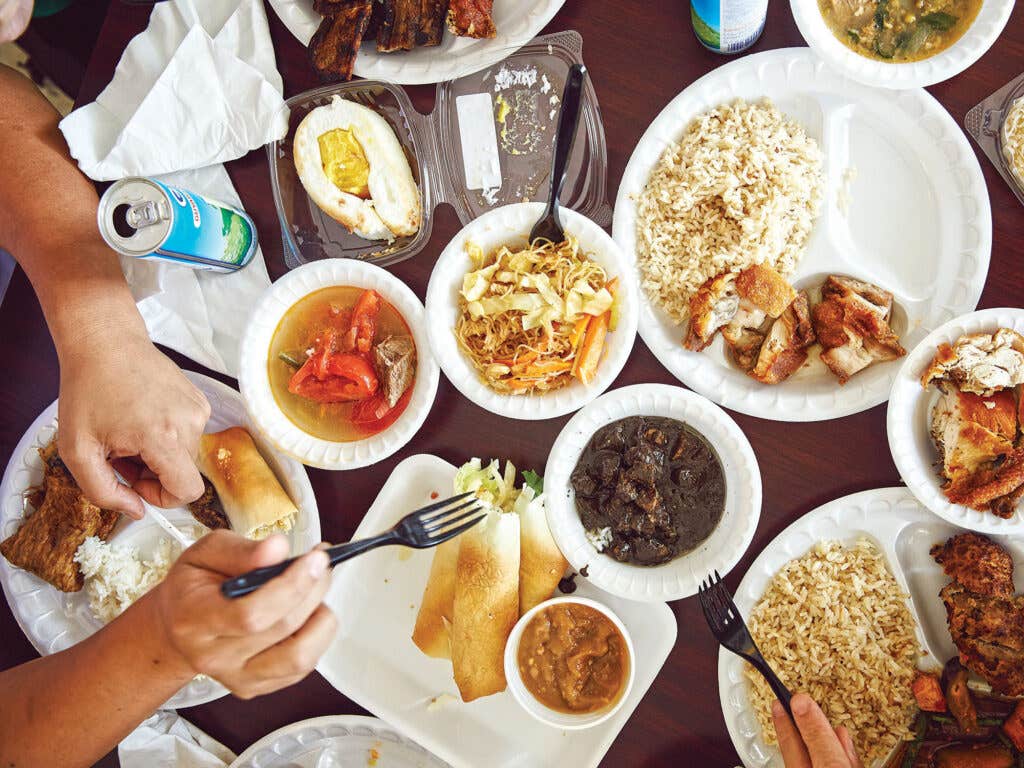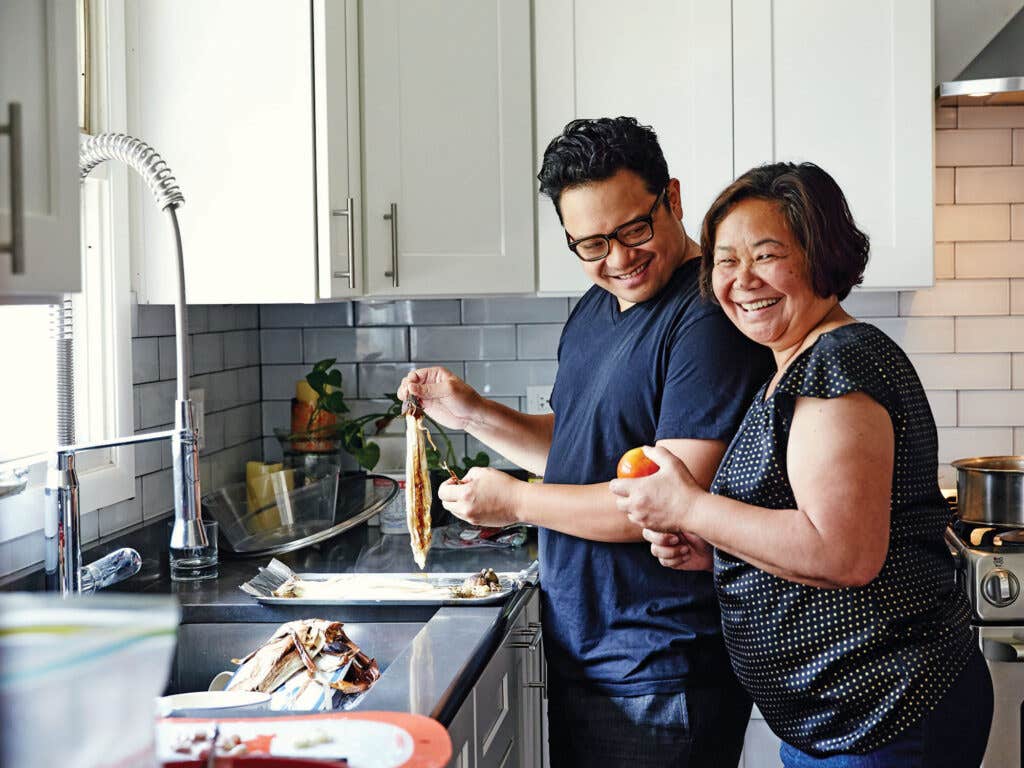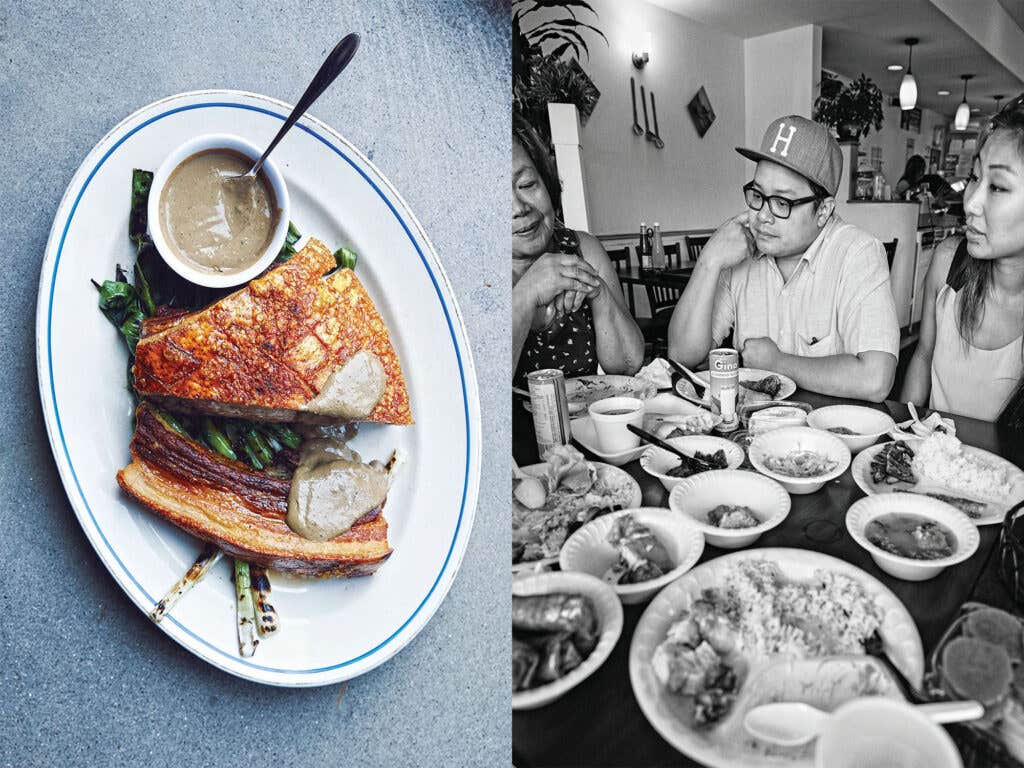
Dale Talde Would Like to Show You the Manila of the Midwest
For the now New York-based chef, the Filipino-American flavors of Chicago’s northwest suburbs—where kielbasa meets ginisang bagoong—taste like home

“I know you didn't want me to cook tonight,” Eva Talde says, greeting us at her home in Niles, Illinois. “But I did. And dinner will be ready in 15 minutes.” Her son, the New York-based chef Dale Talde, wasn't surprised. We'd arrived at his parents' home just outside Chicago with plans to drop our bags and head out to eat a few of his favorite things—tacos from the back of a butcher shop, gyros from a strip mall, pizza topped with gyro meat at a sports bar. Eva had other ideas.
“This is how it is with Filipinos,” he said. “You show up unexpectedly and conveniently someone's pulling a pig's head from the oven.”
Soon we were eating pole beans plucked from vines in Eva's lush garden and sautéed with ground pork, head-on shrimp, and coconut milk. Eva brought out fried fish, sliced green mango, browned sausages that reminded me of kielbasa, and piles of white rice. "Try this," Dale said, handing me a slice of green mango dolloped with ginisang bagoong, a staple seasoning made from fermented shrimp, chiles, tomato, onion, garlic, and sugar. The combination was bracing—the tart, astringent fruit charged with fire and funk. "This is how my grandma used to get down. It's the Philippines in one bite."
This unsolicited meal began a three-day crash course on the upbringing that produced Dale's delirious brand of post-post-immigrant cooking. Ever since we started working together on his cookbook, Asian-American, I've wondered what could possess a French-trained chef to invent dishes like sausage-egg-and-cheese fried rice and kung pao chicken wings with ranch dipping sauce—other than perhaps a marijuana habit. Once we'd finished the book, we planned a trip to Chicago to hang with his mother, so he could show me why he cooks the way he does. A courageous reporter, I decided to embed myself completely: I'd stay at his parents' house, sleep in his brother's old bedroom, and eat every meal with the family.

Before Dale was the chef of several New York City restaurants, including Talde and Pork Slope in Brooklyn, he was a kid who refused to eat sinigang, a soup made sour from tamarind and crowded with the fish heads that his mother bought on the cheap. It's not that he disliked the classic Filipino dish—it's that he had begun to resent its presence in his life. Sinigang stood for all the things he wished were different: He wanted kids not to sneer at the school lunch his mom packed. He wanted to eat at McDonald's like his white friends. He wanted to blend in.
As he got older, he formed an alliance of commiserators, friends of motley ethnicities united by their second-generation Asian immigrant experience. Their homes all stank for different reasons—Dale's from shrimp paste, Robert's from kimchi, and Raj's from asafoetida. With their families, they were foreigners. Together, they were Americans, who listened to American music (hip-hop, mostly), wore Jordans and Starter jerseys, played basketball, and ate American food, which for Dale meant burgers and tacos, kielbasa and hot dogs, egg rolls and deep-dish pizza—anything that wasn't sinigang.
While Dale tried his best to escape Filipino food, his mother tried to keep her heritage alive. A nurse by trade, she came to America from the Philippines in the 1970s, part of the wave of Filipino immigrants arriving after the Immigration and Nationality Act passed in 1965, which eased some of the U.S.'s immigration restrictions. Somehow, between 16-hour hospital shifts, she cooked breakfast, lunch, and dinner for her three children. At first, she made what's known as Fil-Am (or Filipino-American) food—engineering dishes she knew from ingredients she could find. Her cooking became more faithful as the Filipino and Asian communities in Chicago grew (and as she started planting seeds smuggled from the Philippines in her garden), giving her easy access to milkfish (or bangús, a fish popular in the Philippines), sugarcane vinegar, and long beans. Today, her garden includes, among many plants, plots of malabar spinach, yam (grown in part for the plant's edible leaves), lemongrass, and bitter melon.
His mother has lived in and around Chicago for most of her life, but as Dale tells me, “whenever she talks about ‘going home,’ I know she's talking about the Philippines.” Meanwhile, Dale's home pantry—miso and ranch dressing, kimchi and tahini, garam masala and Sichuan peppercorns—reflects his experiences cooking and eating in Chicago and beyond. Yet as I learned, their food has much more in common than I ever realized.
Here in Niles, and in the nearby towns of Park Ridge, Glenview, and Morton Grove, I expected to see the hallmarks of generic suburban food: diners, throwback-style ice cream parlors, Pathmarks, maybe a Chili's. Instead, I found a parade of businesses geared toward partially assimilated immigrant groups, the kinds that give great American cities their character. Within a few miles of one another, you can find a massive and excellent taqueria, several Polish delis, more than a dozen Korean restaurants, and three Target-size Asian supermarkets. Then there's the Filipino enclave: Ian Mae, a crowded, disheveled store selling packaged Filipino products—an instant version of La Paz batchoy (a noodle soup from Iloilo Province), adobo-flavored fried peanuts, jarred macapuno (the gelatinous flesh of mutant coconut)—and prepared foods like turon, a sweet deep-fried spring roll filled with banana and ripe jackfruit. There's Village Creamery, which serves halo-halo ("mix-mix," the hate-it-or-love-it Filipino dessert of shaved ice topped with ice cream, evaporated milk, fruit, beans, and flan) and ice cream in a rainbow of flavors like purple yam, mangosteen, corn and, unfortunately, queso—described distressingly as "vanilla ice cream with Kraft cheese pieces." And there's Sariling Atin, where I joined Dale and his parents for breakfast the next morning.
The strip-mall storefront that houses Sari-ling Atin was once called Franks & Fries, and Dale used to come here for Chicago-style hot dogs, cheese fries, and games of Street Fighter II. Now it's a turo-turo, which in Tagalog, the language on which the national language is based, translates to "point-point," so named because you order by pointing at an array of dishes set out in steam-table trays. I pointed at many things—among them chunks of deep-fried pork belly; pinakbet, a saucy jumble of eggplant, squash, long bean, and bitter melon with a distinct undercurrent of fermented sea creature; and dinuguan, a rich, vinegary blackish stew of pork and pork blood that goes by the euphemistic nickname "chocolate meat" in a futile attempt by Filipina mothers, according to Dale, to endear it to their children.

After breakfast, we dropped into the Shop & Save, the supermarket closest to his mother's house. "A normal American grocery store, right?" Dale said, smiling, as we walked through the produce section, typical but for a particularly robust selection of fresh chiles, tomatillos, and cactus pads. "Then you hit the deli." Here was a vast expanse of glass displaying multitudinous varieties of Polish cured meats, fresh sausages, bacons, and headcheeses. Above that, links of cured sausages, some two dozen kinds, hung from metal hooks.
"My mom shops here all the time," said Dale. "It's close, and more importantly they have a bargain bin." Suddenly I understood why the sausages we'd eaten the night before had reminded me of kielbasa. They were kielbasa. Polish sausage wasn't the only ingredient I would see Eva borrow from her environs. We'd dipped hunks of that kielbasa in a garlic- and chile-infused vinegar—a condiment so omnipresent in his early life that Dale considers it the Filipino equivalent of salt and pepper—that Eva had made, nontraditionally, with habaneros. The next morning I would wake up to a breakfast of sweet plantains and fried rice but also canned corned beef hash mixed with sautéed onion, garlic, and tomato.
Filipino-American food is renowned for this openness, which manifests itself in a certain kind of wackiness. Halo-halo is often topped with off-brand Rice Krispies. Spaghetti is sauced with shredded cheese, hot dogs, and a ketchup clone made from banana. Dale's grandmother, the same woman who loved green mango with shrimp paste, also adored a concoction of Pepsi poured over white rice. A theme of Dale's cookbook is his affection for melted American cheese, McDonald's chicken nuggets, and Pizza Hut pies, which I'd always seen as part of his rebellion. Now I wasn't so sure.
Dale recognizes the comedy in the Filipino embrace of America's finest processed foods but also the tragedies lurking behind it. Many of these products, from ketchup to Spam, came with the American military, which took over the archipelago from Spain after the Spanish-American War, was booted out by the Japanese during World War II, then returned triumphantly a few years later. “People over there loved America for that,” he said. “There are statues and highways named for General MacArthur.”
Foreign occupation is integral to the story of Pinoy (Filipino) food. The influences are many—noodles from China, coconut milk from Malaysia and Indonesia, and chiles from Mexico—but none is as fraught as that of the Spanish colonizers, who arrived in the 16th century and remained for nearly 400 years. Today, Spanish fingerprints are still visible. The country is named for Philip II, the King of Spain. Filipinos have Spanish names: Dale's father is Salvador; his grandmother was Cresenciana Tibajares. His mother speaks Tagalog, as well as Ilonggo, the language of her home province, yet I heard her greet friends with a variation on "Cómo estás?" Menus are a mishmash of Tagalog and Spanish—ampalaya con carne, paksiw na lechon. Some dishes betray a clear colonial origin—empanadas, arroz Valenciana—and others, like adobo, just have Spanish names. Trying to parse the influences can make your head spin: The popular Filipino dish arroz caldo, for instance, has a Spanish name ("rice soup") but comes from China, essentially a riff on congee.
This culinary complication was on display later that night at dinner. Eva was almost finished with a marathon cooking session. Dale had just ordered an emergency pizza after learning that I had never had deep-dish from Pequod's, a 46-year-old local favorite. When it arrived, Dale's attention was trained on the Chicago-style marvel, an inch-deep basin of dough, molten cheese, and tomato sauce. But I couldn't focus on anything except his mother's busy stove.
Eva was cooking food from her home province, including approximately zero of the dishes I associate with Filipino cuisine. There was no lumpia, the crunchy deep-fried spring rolls. There was no pancit, the stir-fried rice noodles. There was no deep-fried pork. There was adobo, but it was almost unrecognizable.
As you may expect in a country of more than 7,000 islands, identity and food in the Philippines vary by region. "The saying goes 'You become Ilonggo before you become Filipino,'" Eva said. In a typical interaction, Dale warmly mocked his mother for her insistence on doubling the name of her native province, calling it "Iloilo Iloilo." (Filipino languages are big on reduplication—halo-halo, turo-turo, sapin-sapin, and salo-salo.) "Mom, it's just Iloilo, I looked it up," he said. "Dale, it's where I'm from!" she shot back.
For the Ilonggo version of adobo, she boiled chicken parts in a mixture of water, sugarcane vinegar, and annatto but didn't stop when the meat was tender. She kept cooking until the liquid had evaporated, leaving behind a ruddy slick of chicken fat in which she then fried onion and garlic. The result wasn't the brothy adobo I'm used to but a heap of legs, thighs, wings, and livers that tasted especially sharp from vinegar.
“When I was a girl, we didn't have refrigeration, so we used vinegar to cook meat and help preserve it,” she said. At that, Dale rolled his eyes. When Eva told me that her mother expected her to know how to make rice over a wood fire by age two, Dale chimed in. “She also walked to school in a monsoon,” he said.

As the adobo bubbled away, I watched as Eva dropped two small dried fruits into a pot. "They're called iba and batuan in my language," she told me. "I don't think they have words for them in Manila." The fruits are souring agents for a dish that goes by KBL, an abbreviation for its main ingredients—kadios (beans), baboy (pig), and langka (jackfruit). I was disoriented by the color, tinted purplish black from the beans, and the dish's dueling fragrances: the very Latin smell of dried legumes stewing with pork and the very Asian smell of tart fruit. There was a soup made from boiled chicken carcass and finished with horseradish-tree leaves that Eva brought back from a trip to Florida. There was a tangle of long beans sautéed with shrimp paste, and an unassuming but incredible mash of grilled eggplant cooked with onion, garlic, tomato, and egg.
Soon, it was dinnertime and Dale's whole family sat at a table crowded with food. "We ate this kind of stuff every day, but that?" said Dale, motioning to the leftover pizza on the counter. "That was special." Yet now he sees them both as special. "My mom's an amazing cook and if she didn't feed us like she did, my food would be boring as hell," he said. Pizza might have been a compelling treat, but it's shrimp paste and chiles that are imprinted on his palate and that give even his most American-seeming dishes their impact.
As they ate, Eva's children discussed the Filipino dishes that they never liked. Dale still doesn't like bony milkfish stewed in vinegar, which is Eva's favorite breakfast. His sister, Aileen, still doesn't care for ginisang bagoong. As a kid, his brother, Rhett, hated bitter melon, just as his mother once had: "When I was a kid and saw lunch was bitter melon, I would cry," Eva admitted. Now she adores it.
As her kids cleared the table, Eva approached what was left of the pizza and looked at it contemplatively. She picked up a slice and took a judicious bite. “I don't like it,” she said. “It's all bread.” Then she took another bite.
Get Dale Talde's Filipino Recipes
Filipino Roast Pork Belly with "Lechon" Sauce
Slow-roasted belly stands in for the classic whole suckling pig that graces virtually every special occasion in the Philippines. Chef Dale Talde also swaps out the sauce’s pungent pork liver for more mellow and easier to source chicken livers. Don’t worry, though. It still tastes, as Talde lovingly puts it, like “liverwurst mixed with sweet and sour sauce.” Get the recipe for Filipino Roast Pork Belly with “Lechon” Sauce »
Deep-Fried Pork Spring Rolls (Lumpia)
Best known in their deep-fried iteration, lumpia often crackle beneath the teeth. But not always; some come wrapped in fresh egg crepes, while others are wrapper-less. Connoisseurs pine for a version made with shrimp, pork, and shredded coconut palm. The freshly fried version is a marvel, the wrapper crisp, the filling’s texture delicate and yielding. Instead of the common sweet-sour dipping sauce, chef Dale Talde opts for the condiment he used growing up—a mixture of vinegar and soy sauce spiked with raw garlic and fiery chiles—which he likens to the salt and pepper of Filipino food. Get the recipe for Deep-Fried Pork Spring Rolls (Lumpia) »
Pork Noodle Soup with Shrimp Paste (La Paz Batchoy)
A regional soup packed with egg noodles and pig parts, La Paz batchoy was born in the La Paz district of Iloilo city, in the province where chef Dale Talde’s mother was born. Talde’s version streamlines the traditional recipe, keeps the liver and intestines optional, and applies just enough shrimp paste to keep things funky. Get the recipe for Pork Noodle Soup with Shrimp Paste (La Paz Batchoy) »
More Filipino Food
Keep Reading
Continue to Next Story










